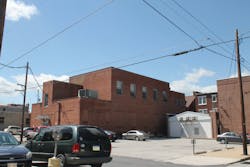6/13 App - Knowing Your First-Due: Out of Sight, But not Out of Mind
This month, we look at what is located out back – or how well do you know side C? In May, we discussed the importance of the 360-degree size-up and seeing what surprises await you in the rear of a structure.
When was the last time you cruised the alleys or rear of structures in your first-due area? If you get out and take a look, you may be surprised at what you find. Knowledge is power and everyone should have a strong knowledge base. Look at the types of building construction present and the associated hazards. Is there any mixed construction? Are there signs of building decay and weakness such as star plates or reinforcing bars?
Access and Apparatus Placement
What appears in the front is not always what appears in the back, so be sure you compare the front to the back during training size-ups. Identify apparatus access issues and particularly any obstructions, including aerial access obstructions.
A key point to consider is building and yard layouts at the rear. Can you access the rear of the property with your apparatus? How is accessibility for manpower and tools?
Setbacks or additions will present problems for manpower and apparatus access to high points, including roofs for ventilation or rescue efforts.
Take a look at your engine company apparatus and see how your hoselines are set up for line advancement. For long or unusual stretches to or from the rear, consider leader lines, break-apart nozzles, manifolds, water thiefs or dead loads to extend your hose. It could be time to review your training books to make sure you can successfully make the stretch from the rear.
What forcible entry and exit issues exist, such as bars on windows and doors, glass block windows and heavy-duty security doors? Heavy building protection may facilitae the need for more specialized units with saws or tools.
Layout and Occupancy
Knowing the layout of the building isn't an easy job from the exterior and you may not be able to determine if the access is split or divided from the front and rear.
Utility locations can offer a lot of intelligence. For example, the number of electrical meters usually provides a good sign of how many apartments/units you have.
Is a larger building blocking the view of or hiding a small building in the rear or hiding exposures? Are there multiple additions to the rear of the structure that are hidden from view from the front? Take some time to look around to see if
you have any alley garages have been remodeled for living or business use. What are the uses and occupancy loads for the businesses?
Pre-Planning
After you access the C side of the buildings in your area, you must ask yourself if you have set up your box assignments for what challenges you will encounter. Assigning a truck and engine to the rear automatically is always a wise choice to make sure you have things covered.
During fire inspections or pre-plan trips, firefighters should ensure that commercial occupancies have the business names visible on the rear and that fire department connection and water supply areas are clearly marked and accessible.
Other factors to determine in the rear include storage areas, vehicles for parking or delivery that can be parked against the building and if dumpsters are stored next to the building. A vehicle or dumpster fire next to a building can easily become a structure fire. These items also can cause access or egress issues.
In the April issue, we talked about the advantage of obtaining overhead views before attaching overhead or aerial photos to your pre-plans. Looking at them on a smartphone or tablet will provide valuable information by giving you a complete picture.
In summary, it is a simple concept that firefighters need to just get out and spend some time taking a look around and sharpening their size-up skills for the rear of your structures.
Remember, it is just as important to know what's going on in the back as it is in the front. Don't forget your 360-degree size-up and pre-plan and to assign someone to be your eyes and ears on side C. Just because it is out of sight does not mean it should be out of mind.
It doesn't matter if you are on Main Street Mayberry or at a large office building in the metropolis, or at strip malls or garden apartments. Get out of the station and get to the rear of your structures and see what's going on.
I have said it before: the loss of a brother or sister due to a lack of knowledge is unacceptable.
Sidebar 1:
Tips to Consider When Accessing the Rear of the Building
• Building and yard layouts
• Apparatus access
• Setbacks or additions
• Is there split access from the front and rear?
• Entry and egress concerns
• Hoseline access
• Understand the differences between the front and rear
• Establishing box assignments based on special needs
• Are your box assignments set up to meet challenges?
• Are building addresses and names properly marked?
• Fire department connections and utility locations
• Are commercial occupancies required to have the business name visible on the rear?
Sidebar 2:
IMAGE: first-due-promo.jpg
Text: "If you haven't downloaded the past editons of the Firehouse Limited Edition Tablet App, look for other articles in this series: March "Long Driveways & Private Access Roads," April: "Top Views for Size-Up" and May: "7 Lessons Learned from an Apartment Fire."
